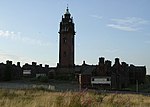Saracen Foundry
1850 establishments in ScotlandCompanies established in 1850Defunct companies of ScotlandFoundries in the United KingdomIronworks and steelworks in Scotland ... and 2 more
Manufacturing companies based in GlasgowUse British English from July 2015

The Saracen Foundry was the better-known name for the Possilpark, Glasgow–based foundry company W MacFarlane & Co. Ltd, founded and owned by Walter MacFarlane. MacFarlane's was the most important manufacturer of ornamental ironwork in Scotland.
Excerpt from the Wikipedia article Saracen Foundry (License: CC BY-SA 3.0, Authors, Images).Saracen Foundry
Hawthorn Street, Glasgow Possilpark
Geographical coordinates (GPS) Address Nearby Places Show on map
Geographical coordinates (GPS)
| Latitude | Longitude |
|---|---|
| N 55.88748 ° | E -4.25412 ° |
Address
Hawthorn Street
Hawthorn Street
G22 6HY Glasgow, Possilpark
Scotland, United Kingdom
Open on Google Maps






